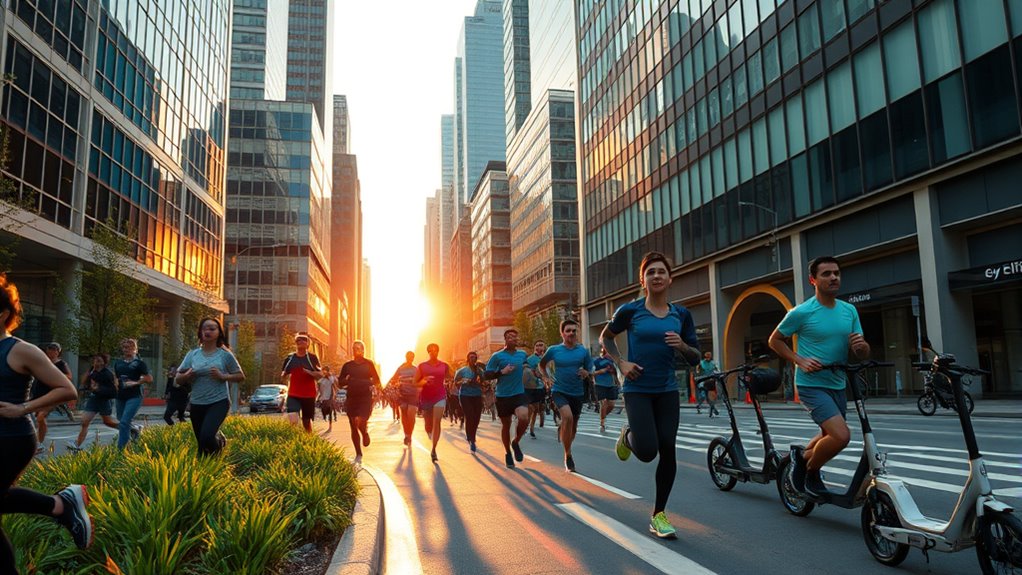Run commuting has gone mainstream as more people prioritize health and environmental benefits. City infrastructure now offers dedicated paths, bike lanes, and facilities that make running to work practical and safe. Urban initiatives and workplace support encourage active transportation, reducing traffic and pollution. This movement aligns with global efforts for sustainable living. If you want to see how this shift continues to evolve, there’s plenty more to explore.
Key Takeaways
- Growing health and environmental awareness shifted public perception, making running to work a popular, sustainable commute choice.
- Urban infrastructure improvements, such as dedicated paths and facilities, facilitated safe and practical run commuting.
- City campaigns and incentives promoted active transportation, encouraging more people to adopt running as part of their daily routine.
- Integration of complementary eco-friendly options like electric bikes expanded the appeal and feasibility of active commuting.
- Employers and governments supported active commuting through wellness programs and policies, normalizing running to work in urban settings.

Have you noticed more people running to work than ever before? What used to be a niche activity for fitness enthusiasts has now become a mainstream way to commute, driven by a mix of health consciousness and environmental awareness. Urban fitness plays a big role here, as cities increasingly encourage active transportation to reduce traffic congestion and improve residents’ well-being. Running to work isn’t just about personal health anymore; it’s a statement against sedentary lifestyles and car dependency. More people realize that incorporating running into their daily routine can boost energy levels, sharpen focus, and set a positive tone for the day. With the proliferation of dedicated running paths and bike lanes, running to work feels safer and more accessible than ever. City planners are actively designing urban spaces that prioritize pedestrian and cyclist infrastructure, making it easier for you to integrate running into your daily commute. As a result, running isn’t just a workout; it’s a practical solution to urban mobility challenges. Additionally, some individuals are exploring electric bikes as a complementary sustainable transportation option, which can extend the distance you can comfortably cover while reducing physical strain.
Beyond personal benefits, running to work also has a significant environmental impact. By choosing to run instead of drive, you contribute to lowering carbon emissions, reducing air pollution, and lessening the strain on public transportation systems. This shift toward active commuting helps combat climate change while also alleviating traffic congestion during peak hours. When more people opt for running, it decreases the number of cars on the road, leading to cleaner air and healthier cities overall. It’s a win-win scenario: you get fitter, and the environment benefits. Many city governments have recognized this, launching campaigns and incentives to encourage run commuting. Some even offer shower facilities or secure bike storage at workplaces to make the transition easier. The environmental impact of urban fitness initiatives extends beyond individual choices; it influences city policies that promote sustainable transportation.
As you consider making run commuting a part of your routine, you might feel motivated by the broader movement toward healthier, more sustainable urban living. It’s a simple change that can have profound benefits—not just for your health but for the environment too. Running to work aligns with a growing global awareness of the need to rethink transportation habits and prioritize eco-friendly options. More companies are supporting this shift by creating flexible schedules or offering wellness programs that encourage active commuting. Ultimately, running to work isn’t just a trend; it’s a smart, impactful way to contribute to a healthier city and a healthier planet, all while boosting your daily fitness and well-being.
Frequently Asked Questions
What Are the Health Benefits of Run Commuting?
Run commuting boosts your health by enhancing your aerobic capacity and increasing energy levels. It strengthens your heart, lungs, and muscles, providing sustained aerobic benefits. Plus, it can improve your running motivation by making exercise part of your daily routine, reducing stress, and elevating mood. Regular run commuting helps maintain a healthy weight, boosts immunity, and promotes overall well-being, making it a practical, enjoyable way to stay active every day.
How Do Urban Planners Support Run Commuters?
Imagine city streets transformed into smooth, inviting pathways for runners. Urban planners support you by designing dedicated running lanes and improving urban infrastructure, making your commute safer and more enjoyable. They also implement policy incentives like reduced parking fees or tax benefits for active commuters, encouraging you to choose running over driving. This proactive planning creates a city where running to work becomes a natural, accessible, and sustainable choice for everyone.
What Gear Is Essential for Safe Run Commuting?
You need reflective gear like vests or bands to stay visible during early mornings or late evenings. A good headlamp or bike light can also aid. Carry hydration strategies such as a small water bottle or hydration pack to stay energized. Don’t forget comfortable shoes and weather-appropriate clothing. These essentials ensure you’re safe, visible, and well-hydrated, making your run commute both enjoyable and secure.
How Has Remote Work Affected Run Commuting Trends?
Remote work has decreased the number of daily run commuters, but it’s also prompted companies to adopt flexible policies encouraging active lifestyles. You might now see more corporate policies supporting run commuting or incentivizing eco-friendly travel, reducing your environmental impact. Although fewer people run to work consistently, those who do benefit from a healthier routine and contribute to sustainability efforts, making run commuting more sustainable and aligned with environmental goals.
Are There Safety Concerns for Night Run Commuters?
Like Icarus flying too close to the sun, night run commuters face safety risks. Nighttime visibility can be limited, so you must prioritize personal safety measures. Wear reflective gear and carry a flashlight to stay seen, and choose well-lit routes. Stay alert and avoid isolated areas. These precautions help you navigate the dark safely, ensuring your run remains enjoyable without undue risk.
Conclusion
It’s clear that run commuting has become mainstream because more people realize the health benefits and environmental impact. While some argue it’s just a trend, evidence shows it’s a sustainable lifestyle choice rooted in practicality and wellness. By integrating running into your daily routine, you’re not only improving your fitness but also contributing to a greener planet. Embracing this movement proves that small lifestyle changes can make a significant difference—so why not give it a try?









